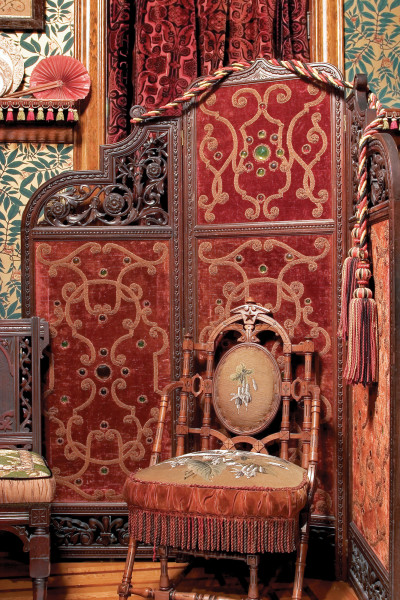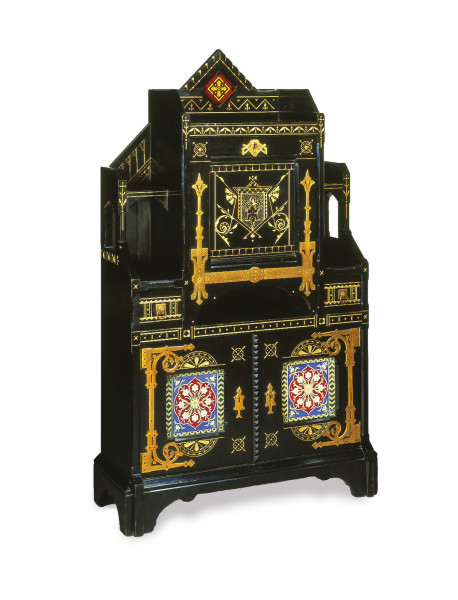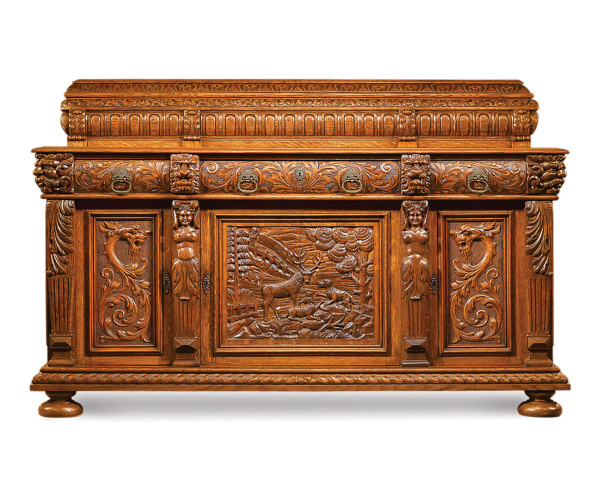Books and products mentioned in oldhouseonline stories are chosen by our editors. When you buy through links on this site, we may earn an affiliate commission.
Following the Civil War and the nation’s return to economic prosperity, ornately decorated interiors proliferated. Properly furnished rooms were a sign of education and good taste, and a way to show off one’s wealth. Furniture makers began producing furniture in exotic styles from Renaissance to Modern Gothic.
George Hunzinger

George Hunzinger.
Linda Svendsen Archive
The cabinetmaker immigrated to the United States from Würrttemberg, Germany, in 1855, and opened a furniture business in New York City, which he operated with his son until George Sr.’s death in 1898. Hunzinger produced a wide range of “fancy” chairs, folding and lounge chairs, platform rockers, tables, settees, and daybeds. Hunzinger sometimes featured geometric elements such as cones and spheres, and his well-known “lollipops” still seem modern. His designs were functional, often influenced by mechanics, and not purely historical.
Hunzinger patented 21 designs, including, in 1869, a cantilevered seat supported by diagonal braces that continued as legs; it became a signature of his work. He is also known for his 1888 invention of threading wires through the chair seat and back, each wire adjusted by a nut, eliminating the common problem of loosening joints. His work is typically stamped or has a paper label. The best reference for Hunzinger’s work is Barry Harwood’s book The Furniture of George Hunzinger: Invention and Innovation in Nineteenth-Century America.
Kimbel and Cabus

Kimbel and Cabus.
Courtesy Brooklyn Museum: 1991.126_IMLS_SL2
This New York City-based furniture and decorating firm was founded in 1862 by two cabinetmakers, German-born Anthony Kimbel and French-born Joseph Cabus. The company became known for its Modern Gothic (Aesthetic Movement) and Anglo–Japanese furniture.
The firm received great praise at the 1876 Philadelphia Centennial Exposition for their Modern Gothic pieces, which were considered a breath of fresh air after the “excesses” of the elaborate rococo designs of earlier Victorian decades. Wood, often cherry, was frequently ebonized, and decorated with angular and incised gilt lines. Colorful tiles, painted panels, and robust nickel-plated strapwork were added decoration.
Although this Reformed Gothic style was short-lived—tastemaker and author Clarence Cook pronounced it passé by 1878—the style and its antecedents would become influential once again during the English Arts & Crafts movement. Kimbel and Cabus were in business for only two decades, dissolving their partnership in 1882. Learn more through the company’s 1875 trade catalog, online through the Cooper–Hewitt Smithsonian Design
Museum: library.si.edu/image-gallery/collection/kimbel-and-cabus
Robert J. Horner

Robert J. Horner
Courtesy M.S. Rau Antiques
Horner opened in New York City in 1886, advertising “First-Class and Medium-Quality Furniture” to serve both wealthy and middle-class markets. R.J. Horner & Co. produced a wide range, primarily in oak and mahogany due to a shortage of walnut. The output ran from dining-room sets to hall trees, upholstered parlor sets to desks. Horner’s furniture is marked by heavily carved surfaces covered with griffins, gargoyles, cherubs, and gadrooning.
Identifying Horner furniture can be difficult, as other makers including Mitchell & Rammelsberg worked in a similar style. Horner merged with George Flint by 1915; Horner & Flint operated until about 1930.







